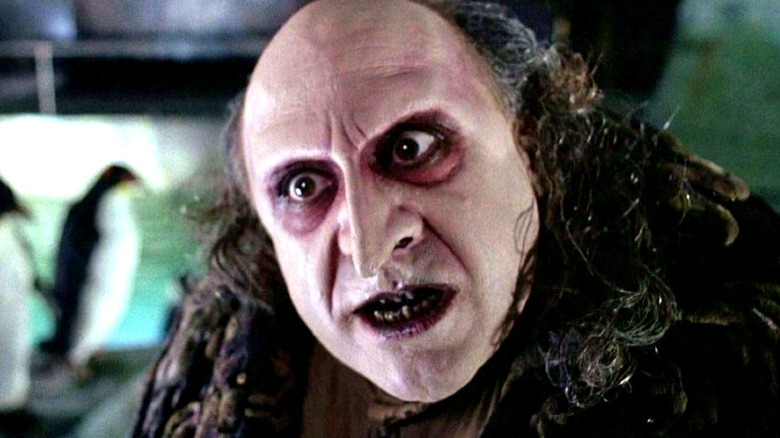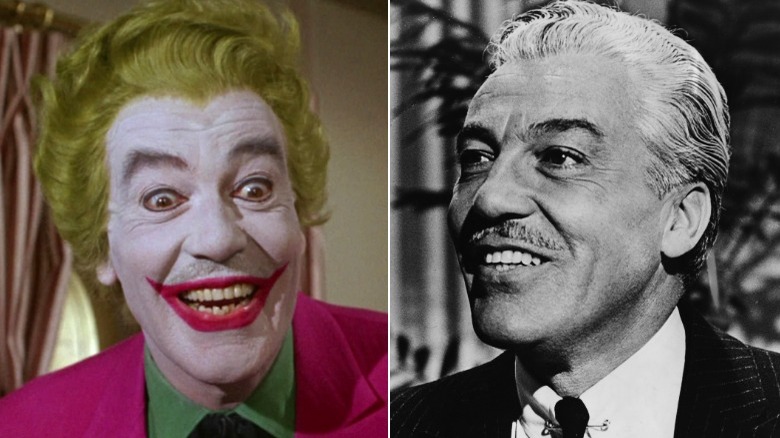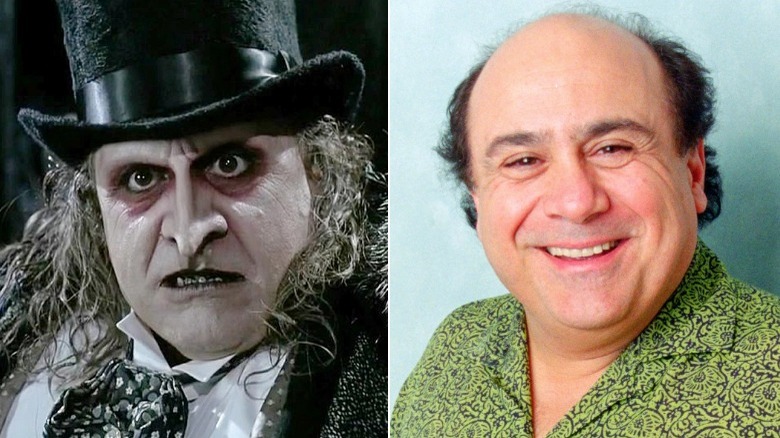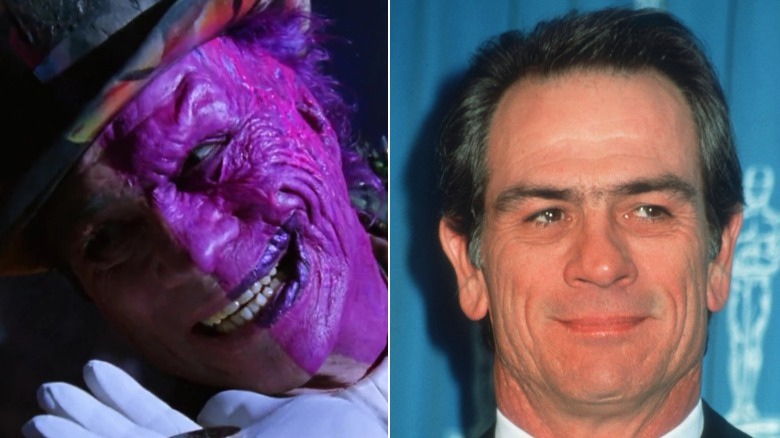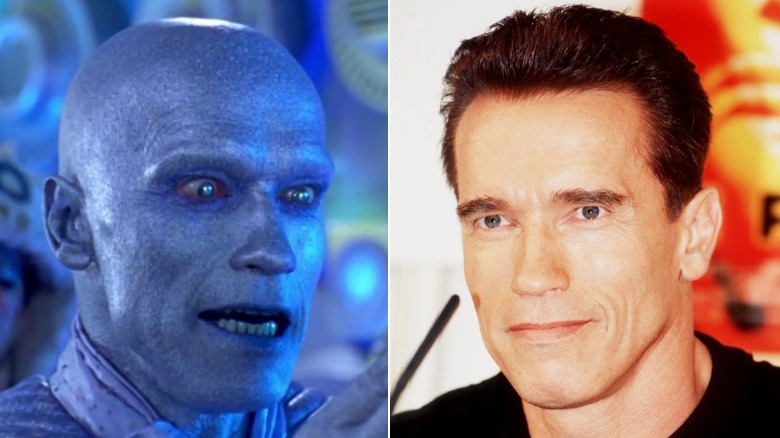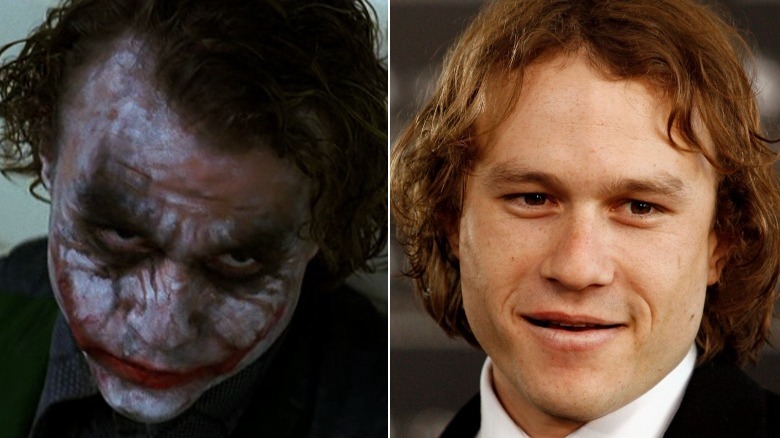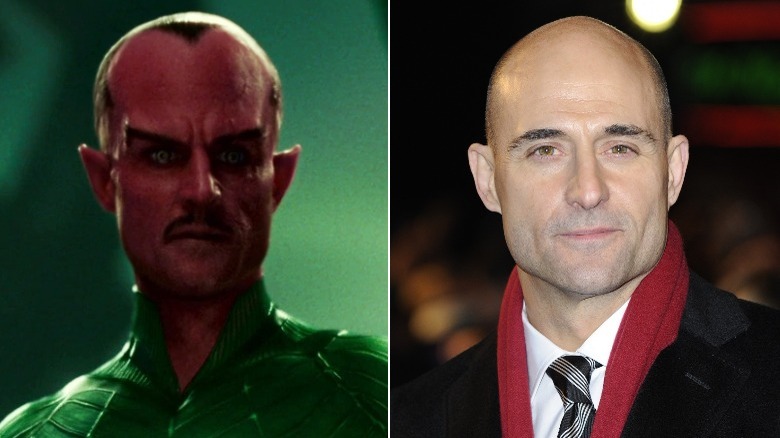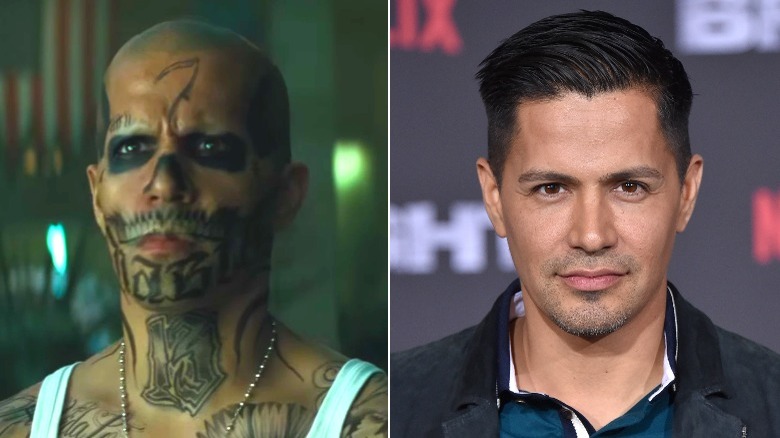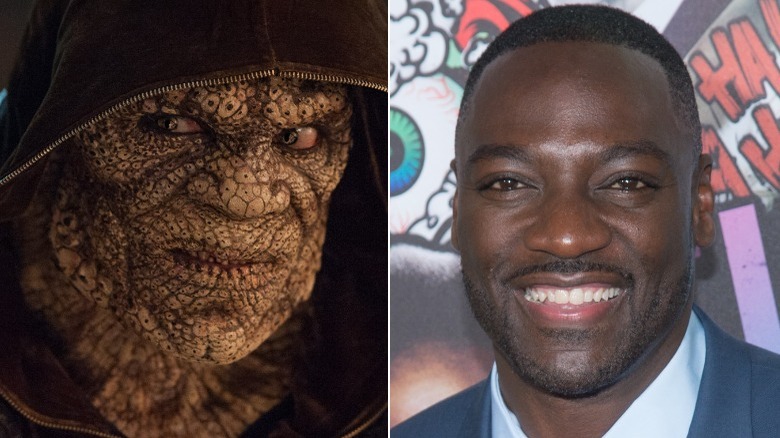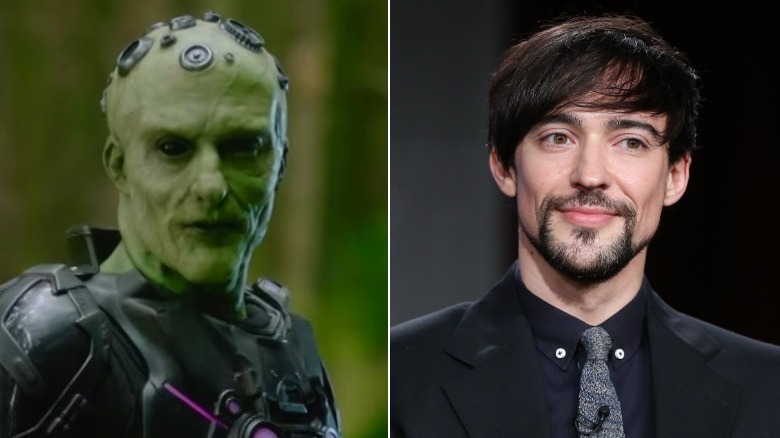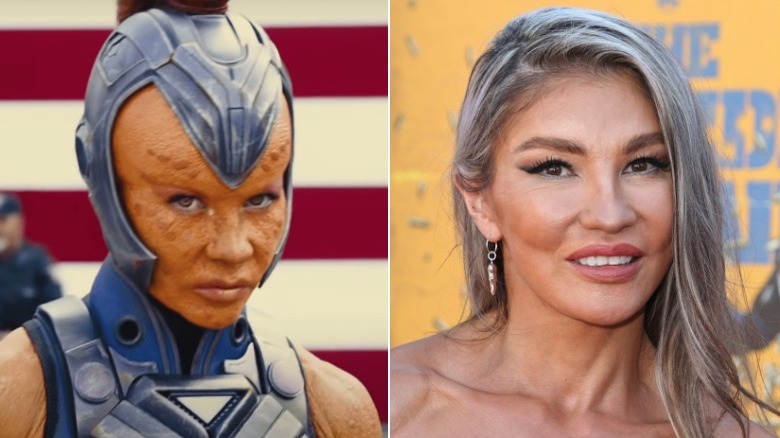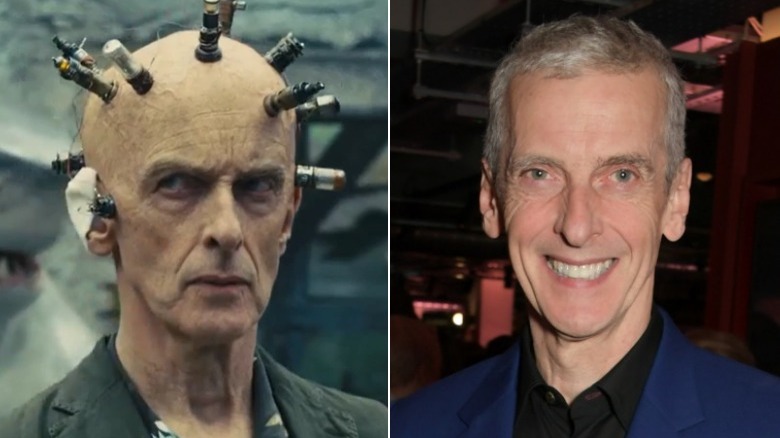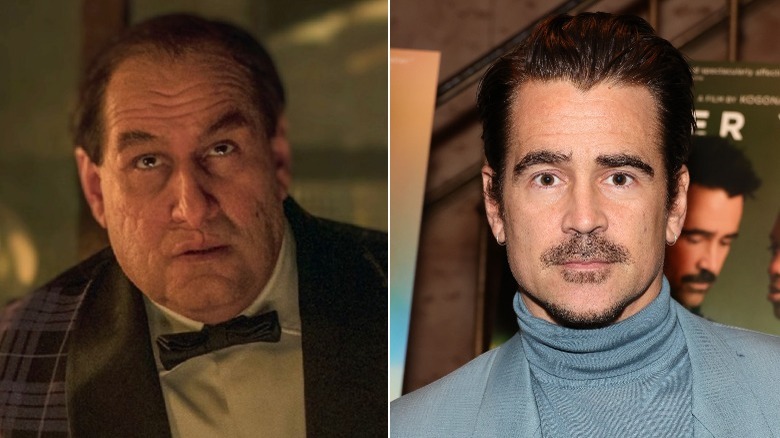What These DC Villains Really Look Like Under The Makeup
DC Comics' rogues gallery is filled with an eclectic array of villains, many of whom look just as fearsome as they act. On the page, artists can splash colors and stretch proportions to create memorable characters as needed, but what happens when they need to appear on the silver screen?
CGI may be a popular method for bringing comic book characters to life, but nothing beats traditional hair, makeup, and prosthetics. Many of the most beloved performances in DC's (admittedly rocky) filmography could only have been achieved through long hours in the makeup chair. It may not be easy to act through silicone or face paint, but the results are movie magic when the right talent is involved.
But how familiar are you with the faces behind the names? Do you know the details behind their metamorphoses? If not, we're here to give you the skinny — even hardcore fans may learn something new.
First, though, some stipulations. This list is going to focus on characters that spend most of their time in makeup, with exceptions made for brief flashbacks. While actors like Jack Nicholson and Aaron Eckhart turn in tremendous performances in their DC films, you already know what they look like; their faces go untouched for a significant portion of their respective movies' runtimes. Further, we want to highlight the deepest departures from an actor's normal look. No offense to Margot Robbie, but she isn't exactly "disguised" as Harley Quinn, for example. And with that, let's begin!
Cesar Romero as The Joker
Most people fondly remember Cesar Romero for his goofy take on Batman's arch-nemesis in the 1966 "Batman" television series. However, before he was the Clown Prince of Crime, he was the Latin from Manhattan; as a suave and sophisticated leading man, he was being cast against type as a Gotham villain. After all, most people wouldn't consider Romero's devilish good looks as a canvas for the Joker's clown makeup.
But lo and behold, "Batman" makeup gurus Ben Nye Sr. and Butch Hutchinson fully transformed Romero into the first ever live-action Joker. Disguised in white face paint, excessive red lipstick, and a glued-on green wig, he was practically unrecognizable after only an hour of application time. According to Romero, as quoted in "The Official Batman Batbook," playing Mr. J gives one the freedom to "let go, let loose, and not be yourself at all."
He wasn't willing to fully let loose, however. According to an interview with Adam West, Romero refused to shave his mustache out of fear that he would lose his reputation as a "Latin lover." The makeup team tried to cover up his facial hair, but even a passing glance reveals bristles poking through the face paint. While the decision was initially mocked, fans of the show now consider this a fitting choice. As Laura Bradley writes in Vanity Fair, "The 'stache ... simply adds to the character's zany absurdity."
Danny DeVito as The Penguin
In a stark contrast to the campy "Batman" TV show, Tim Burton's take on the Batman universe was a Gothic tragedy. As such, the aristocratic Oswald Cobblepot was turned into a deformed creature who was abandoned by his parents and left to the mercy of Gotham's sewers. Such a drastic reinvention would require visionary artists to bring it to life — enter Stan Winston and Ve Neill.
The process to turn Danny DeVito into the Penguin began with a nose prosthetic. Winston designed the mold, ironically using a crow's beak as inspiration (via The Stan Winston School). In the featurette "Making Up the Penguin," Neill blends the prosthetic with the rest of DeVito's face before applying dark circles to his eyes, black lipstick, and extra definition to DeVito's folds and wrinkles. The actor's mouth was then decked out with dentures. The makeup department even concocted a unique ooze for the Penguin's saliva: a mixture of mouthwash and food coloring that DeVito would squirt into his mouth in between takes.
DeVito's intense three-hour makeup job inspired him to stay in character on set. According to artist Shane Mahan, who oversaw the design of the makeup, DeVito even "went to the trouble of having the makeup put on him" during voiceover sessions for the film. That level of commitment should speak for itself.
Tommy Lee Jones as Two-Face
Having a face scarred by a bucket full of acid may lead to a rough life, but when you get to sport a Rick Baker original, it's worth it. The award-winning makeup designer brought his genius to Joel Schumacher's "Batman Forever," primarily helping to create Two-Face's deformity. Though the design strayed from the comics — you won't find a bulging eyeball or exposed teeth here — Schumacher's vision for Two-Face was incredibly well-realized.
In an interview with ScreenSlam, Tommy Lee Jones explained that the look consisted of 11 different pieces of latex, applied "in degrees." There were different appliances for Two-Face's ear, lips, cheek, and so on, all painted and blended together in a bombastic magenta (via Tom Spina Designs). In an interview with Bobby Wygant, Jones noted that the latex was "very responsive to the muscles in one's face"; each separate piece individually responded to its own section of Jones' head, allowing him to emote through the makeup.
Though Jones respected Baker's designs, his skin would be "distressed" after a week's worth of application. He described it as if "some monster from outer space had ... decided to live on one side of your head for a day." In a retrospective interview with The Hollywood Reporter, director of photography Stephen Goldblatt mentioned that the makeup "didn't put [Jones] in the best of tempers at all times." Considering that Jones did not have a great time shooting "Batman Forever," we can infer that the makeup probably irritated him even further.
Arnold Schwarzenegger as Mr. Freeze
Arnold Schwarzenegger was at the height of his powers when he signed on to do "Batman and Robin"; he even brought on Jeff Dawn, his personal makeup artist, to handle his transformation into Mr. Freeze. It was primed to be another successful collaboration, but there were many hurdles along that way that made Mr. Freeze a production headache.
In the featurette "Frozen Freaks and Femme Fatales," Schwarzenegger notes that all of his body hair was covered to sell Freeze's horrible accident. According to a retrospective interview with The Hollywood Reporter, Dawn originally convinced Schwarzenegger to shave his head for the role, which would have saved significant time in makeup. However, at the last second, Schwarzenegger refused. A collection of behind-the-scenes photos gives us some insights into the aftermath, particularly the bald cap and eyebrow coverings required to cover Schwarzenegger's hair, as well as the shimmering acrylic paint that gave Schwarzenegger his frozen look.
The application process for this look ended up taking four hours — five, if you include Freeze's bulky armor. This left only a little bit of shooting time in Arnold's contractually-obligated 12-hour work day. The production worked with doubles to use Schwarzenegger's time as efficiently as possible, but technical difficulties still made things difficult. An LED light was used in Freeze's mouth for certain scenes, but it leaked acid into Schwarzenegger's mouth and frequently ran out of batteries, creating further delays.
Heath Ledger as The Joker
Christopher Nolan's "The Dark Knight" breathed new life into a cultural icon. Several different artists, inspirations, and makeup techniques came together to create a horrifying new face for the Joker in what remains a pinnacle of storytelling through makeup design.
In an interview with Empire, artist Conor O'Sullivan said he based the Joker's facial scar off of a "Glasgow smile," or a razor wound often left by Scottish street gangs. This alludes to the character's backstory. As described by costume designer Lindy Hemming in "The Art and Making of the Dark Knight Trilogy," it was "as though someone attacked him at some point." The Joker's two facial scars also look different from one another. The one on the lift is spindly, while the one on the right is wider and shorter. This is anatomically correct; depending on where and how you cut skin, the wound will look different, and the two different scars further illustrate the Joker's anarchic nature.
Inspired by the Francis Bacon painting, "Study after Velázquez's Portrait of Pope Innocent X," Joker's clown makeup speaks to "a guy who is breaking down internally." Ledger would scrunch his face as makeup artist John Caglione applied the face paint, creating visible cracks in the makeup, and his dark eye makeup would be smudged. The final touch was the red lipstick, which Ledger applied himself to get into character.
Mark Strong as Sinestro
Batman isn't the only DC hero who has had his most memorable villains brought onto the big screen. Sinestro is one of Green Lantern's most formidable foes, despite being portrayed as an anti-hero in the 2011 film; a post-credits scene set him up to be the big bad in the sequel, but the first film was lambasted so heavily that plans for a follow-up were immediately scrapped.
Still, even the most critical fan can admire how comic book-accurate Mark Strong looks in the part. For that, you have Strong himself to thank. In an interview with Digital Spy, the acclaimed British actor spoke about how he became "slightly hooked" on the character of Sinestro after performing extensive research. The creative team was set on a redesigned version of the character, closer to a "Maori warrior type" with a ponytail and goatee, but Strong insisted they stick to the character's original, "iconic" look. Strong greatly enjoyed working in the makeup, telling Collider it felt "almost Shakespearean."
As seen in the featurette "Acting Under 10 Pounds of Silicone," makeup artists Joel Harlow, Steve Buscaino, and Richie Alonzo designed and applied a two-piece head prosthetic for Strong, as well as pointed ears. Once it was all blended together, the artists colored Strong's skin via both airbrushing and hand-painting; in an interview with The Globe and Mail, Strong said that nine different shades were blended together to create Sinestro's magenta skin. Finally, fake hair was applied to Strong's scalp, brows, and upper lip to complete the look.
Jay Hernandez as El Diablo
Sure, "Academy Award-winner 'Suicide Squad'" is still weird to say out loud, but give credit where it's due: The film, which won an Oscar for best makeup and hairstyling, has some pretty impressive transformations. One of them was Jay Hernandez as El Diablo. According to Hernandez, the El Diablo's look in the film is inspired by the New 52 "Suicide Squad" comics while "taking full ownership" of El Diablo's past as a Los Angeles gang member (via ScreenSlam), a culture that Hernandez himself was exposed to growing up in LA (via NALIP).
Hernandez's body was heavily tattooed to create a "gangster Cholo" look. In one of the film's featurettes, "Chasing the Real," Ayer says that each of the tattoos, which were designed by artist Rob Coutts, "has its own specific story"; some are obvious, like the Grim Reaper's scepter on his forehead, or the angelic illustration of El Diablo's dead wife on his left arm. Others are subtle, like the "213" on his left hand, which is a common Los Angeles area code (via USA Today).
Though the character's design began with just a few tattoos, it evolved to the point that his entire visible body was covered in paint. It initially took five hours to apply everything using a combination of painting, airbrushing, and sealants. However, Hernandez was eager to get tatted. "The more I don't look like me, the better it's gonna be," he said. He even took the initiative and shaved his head and eyebrows for the role, as doing so saved him 30 minutes in the makeup chair (via Young Hollywood).
Adewale Akinnuoye-Agbaje as Killer Croc
El Diablo's look may have been extreme, but as far as "Suicide Squad" is concerned, Killer Croc's metamorphosis takes the cake. In a film with plenty of CGI effects, Adewale Akinnuoye-Agbaje's transformation was done 100% practically, proving that you can make monsters come to life without sacrificing an actual performance.
In an interview with Collider, Akinnuoye-Agbaje said that the full body look was achieved via eight individual prosthetics, all blended together with body paint. Each piece contained up to two inches of foam latex (via THR), but because the makeup was firmly glued on with an adhesive, the actor was able to remain expressive. He even practiced calisthenics so that he had the flexibility to work through the makeup's weight during fight scenes.
What makes Killer Croc so unsettling is his human-like design. According to "Chasing the Real," Ayer had always planned on basing Croc on the original Batman comics. In his first appearance, Waylon Jones suffered from a condition that made his skin resemble scales; this is as opposed to more recent iterations of the character, which are closer to a walking, talking crocodile. In an interview with Halloween Daily News, makeup artist Christopher Nelson said he took inspiration from the real-life skin condition vitiligo, in which patches of your skin lose color. He incorporated that feature into a "really contrasty" pointillist design. Ayer also decided that Croc's coloring should be built around Akinnuoye-Agbaje's skin tones — "browns and beiges" — as opposed to the simpler greens usually associated with crocodiles.
Blake Ritson as Brainiac
Many DC fans skipped Syfy's short-lived Superman prequel series, "Krypton." However, those who gave it a chance were treated to the first ever comics-accurate live-action appearance of Brainiac, one of Superman's greatest foes.
Taking direct inspiration from Geoff Johns and Gary Frank's "Superman: Brainiac" arc, Mario Torres' design for the character was a full-face silicone mold. It was painted a sickly green with holes on top of the head, as well as grotesque twisting at the neck. British actor Blake Ritson, who portrayed the character, called it "unequivocally the scariest incarnation of Brainiac to date" in an interview with KryptonSite, and it's hard to disagree. While staying true to the comics, this Brainiac has a far ghastlier, almost slimier presence.
In what marks the most time-consuming makeup job on this list — ironically, a record held by the only television series we're discussing — it initially took seven hours for everything to be applied (via USA Today). In the featurette "Becoming Brainiac," a time-lapse video of the application process shows how much artists Clare Ramsey and Charlie Bluett had to accomplish: There were three separate appliances on the face that needed to be blended together, veiny texturing across the whole mold, and lipstick and contact lenses. While spending all that time in the chair, Ritson would blast a themed playlist to get into character. Talking to Syfy, he revealed its bizarre contents: "Digital white noise, kids chanting, hardcore Japanese hip-hop, Count von Count, aggressive synthwave, and Mongolian throat singing." Talk about scary.
Mayling Ng as Mongal
James Gunn has tweeted about using "practical effects whenever possible" on "The Suicide Squad." Despite her minimal screen time, Mongal is a shining example of the results. Actress and martial artist Mayling Ng was decked out in practical effects from head to toe — even her burnt corpse, which appeared during the film's opening bloodbath, was built from scratch (via The Stan Winston School).
Legacy Effects makeup artist Shane Mahan, who also worked on DeVito's Penguin, designed Mongal's look. She sports "a very tight reptilian skin," which was achieved through "a combination of silicone and Pros-Aide transfers that were painted orange." As seen in a time-lapse video posted to the actress' YouTube channel, Ng's bald cap and forehead prosthetic appear to be made out of silicone, while the rest of her face makeup is accomplished through these transfers. Ng's arms, legs, and neck were also coated in transfers, fully immersing her in Mongal's alien skin. Ng credited artist Brian Sipe for getting a four-hour makeup process down to two-and-a-half by the end of shooting.
In an interview with Nerd Reactor, Ng spoke about the all-too-powerful sealants they used to preserve the makeup. "They will seal it, and then I couldn't get it off," she said. "So there were a few times where they panicked a little bit." They tried rubbing alcohol, chemicals, and, finally, a sauna. Still, Ng toughed it out. "It's just part of the job, and to be Mongal, I'll do it every day."
Peter Capaldi as The Thinker
Peter Capaldi's cranial swelling as the Thinker in "The Suicide Squad" could be considered one of the more minimal transformations on this list. However, the design process to create the effect was a far more technical affair than is visible in the final film. Most people would assume the look was achieved through a bald cap and glued-on tubes. However, Shane Mahan is quick to dismiss that notion in an interview with The Sam Winston School: "It doesn't work that way."
Not only was an entire prosthetic headpiece designed for the Thinker, but an entire lighting system was built around it. Capaldi cut his hair short so that it could be covered by a "rigid" skull cap. The protrusions were then mounted in place through the headpiece using "screws and magnets." This gave the illusion of the devices coming through Capaldi's head while keeping everything firmly in place. Despite all the visible wiring, all of the lights were actually battery operated in a system designed by artist Scott Patton. Pretty impressive!
Even more impressive? In an interview with SAMDB News, Capaldi called the makeup "strangely comfortable." Now that's an achievement! Capaldi also praised the "fabulous makeup team" for making the look "totally convincing," and told Cinemabang that artist Matt Sprunger, who applied Capaldi's makeup every day, gifted him one of the tubes when production wrapped. "I've got [it] on my mantelpiece."
Colin Farrell as The Penguin
You didn't think we'd forget DC's latest and greatest makeup transformation, did you? Colin Farrell's take on Oswald Cobblepot is one of its best looks yet. It was practically a disguise; when "The Batman" dropped its first trailer, you could see fans on Twitter being shocked in real-time as they discovered that Farrell was in the movie, despite his casting having been announced months earlier. They weren't alone. The other cast members didn't recognize Farrell on set, either (via Entertainment Tonight).
Talking to entertainment.ie, Reeves said that he wanted his version of the Penguin to be a mob underling, "kind of underestimated and looked down upon and even made fun of." Farrell had gained weight in his role for "The North Water," and Reeves believed that the extra bulk, plus a simple prosthetic nose, could achieve the effect. But Farrell felt "unhealthy" with the weight, and wished to pursue makeup instead.
Enter Mike Marino, a talented prosthetics designer who sculpted a fat suit for Farrell, in addition to a large silicone face mold. In a time lapse video posted by IGN, you can see the appliance, as well as prosthetics used for his scalp, nose, upper lip, and chin. It gives his face a rugged tone, but the latex was actually soft and elastic, giving Farrell the ability to perform underneath it. Farrell was ecstatic about the result, telling Collider, "When I saw what Mike did, the whole character made sense to me." On "Hot Ones," Farrell said that acting beneath all the makeup was, ironically, "absolute liberation."
